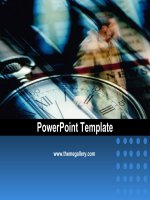PowerPoint template CLAUSE AS EXCHANGE
Bạn đang xem bản rút gọn của tài liệu. Xem và tải ngay bản đầy đủ của tài liệu tại đây (427.08 KB, 54 trang )
LOGO
CLAUSE AS EXCHANGE
Group 4
1. Nguyễn Thị Hoàng My
2. Nguyễn Thanh Tâm
3. Nguyễn Thị Thanh
4. Lê Hương Thảo
Contents
1. The nature of dialogue
2. The Mood element
2
3. Other elements
of Mood structure
4. WH-interrogative, exclamative and imperative clauses
5. Modality
6. Absence of elements of the modal structure
7. Clause as Subject
4.1
THE NATURE OF DIALOGUE
4.1.1
Functions of a clause
A message
Theme
A clause
Rheme
An exchange
Grammatical system: MOOD
4.1
THE NATURE OF DIALOGUE
4.1.2
Speaker and listener in speech role
Speaker: adopts himself a particular speech role
Listener: adopts a complementary role in his turn.
e.g: In a question
Speaker: the seeker of information
Listener: the supplier of the information
demanded
4.1
THE NATURE OF DIALOGUE
4.1.3
Role in exchange
Speech role
Giving
Demanding
Inviting to receive
Inviting to give
4.1
THE NATURE OF DIALOGUE
4.1.4
Giving & Demanding
Role in exchange
Commodity
exchanged
Goods & services
Information
Giving
Offer
Would you like this
teapot?
Statement
He’s giving her the
teapot.
Demanding
Command
Give me that teapot!
Question
What’s he giving her?
4.1
THE NATURE OF DIALOGUE
4.1.5
Speech functions & Responses
Response
Expected
Goods &
services
Information
Offer
Shall I give in this teapot?
Acceptance
Yes, Please.
Command
Give me that teapot.
Undertaking
Here you are.
Statement
He’s giving her the teapot.
Acknowledgement
Is he?
Question
What’s he giving her?
Answer
A teapot.
4.1
THE NATURE OF DIALOGUE
4.1.5
Speech functions & Responses
Examples
Speaker
Listener
Would you like this teapot?
Yes, I would/No, I wouldn’t
Give me that teapot!
All right, I will / No, I won’t
He’s giving her the teapot?
Yes, he is. / No, he isn’t
What is he giving her?
A teapot. / I don’t know
4.1
THE NATURE OF DIALOGUE
4.1.6
Information exchange and Goods-&-services
exchange
Listener
Information exchange
A wide rage of different
responses to a question
Carry out a command in
different ways
Refuse to answer the question
Provide the good & services
demanded
Goods-&-services exchange
Accept or reject the offer
Obey or refuse the
command
4.1
THE NATURE OF DIALOGUE
4.1.6
Information exchange and Goods-&-services
exchange
Examples
- It’s Tuesday
- Is it Tuesday
- What day is it?
– Oh, is it?
– Yes, it is.
– Tuesday.
4.1
THE NATURE OF DIALOGUE
4.1.7
Clause in information exchange & Goods-&services exchange
Information exchange
Proposition
Can be argued about.
(affirmed, denied, doubted,
contradicted, insisted on,
accepted with reservation,
etc.)
A statement, a question
Goods-&-services exchange
Proposal
Cannot be affirmed or
denied.
Offers and commands
2. THE MOOD ELEMENT
Structure of the Mood
1
2
The meaning of subject and finite
2.1 STRUCTURE OF THE MOOD
The man’s given away that 1. What are tossed back and
teapot, hasn’t he?
forth carrying the
Oh, has he?
Yes, he has.
No, he hasn’t.
argument?
He has/hasn’t/will/might
Subject + Finite = the MOOD
I wish he had.
He hasn’t, but he will.
2. What if simply left out?
Will he?
“given away that teapot”
Predicator + Residue
He might.
The MOOD
Subject
(a nominal group)
Finite
(part of verbal group)
Halliday, Introduction to functional grammar, page 72
Example
I
Am
Writing
Subject
Finite
Predicator Complement Adjunct
The MOOD
A letter
Residue
For her
2.2 THE MEANING OF
SUBJECT AND FINITE
THE MEANING OF SUBJECT
The Subject supplies the rest of what it takes
to form a proposition, something by
reference to which the proposition can be
affirmed or denied.
e.g.:
He
has
given it to me.
Subject
Finite
Residue
THE MEANING OF FINITE
Making the proposition finite.
1. Reference to time of speaking
An old man was crossing the road.
PRIMARY TENSE (TEMPORAL OPERATORS)
2. Reference to the judgment of the speaker
It can’t be true
MODALITY (MODAL OPERATORS)
TEMPORAL OPERATORS
Past
Present
Future
Positive
Did, was,
Does, is, has Will. Shall,
had, used to
would,
should
Negative
Didn’t,
Doesn’t,
wasn’t,
isn’t, hasn’t
hadn’t,
didn’t use to
Won’t,
shan’t,
wouldn’t,
shouldn’t
MODAL OPERATORS
Low
Median
High
Positive
Can, may,
Will, would,
could, might should,
is/was to
Must, ought
to, need,
has/had to
Negative
Needn’t,
Won’t,
doesn’t/didn wouldn’t,
’t, need to,
shouldn’t
have to
Mustn’t,
can’t,
couldn’t,
hasn’t
3. OTHER ELEMENTS OF
MOOD STRUCTURE
Structure of the RESIDUE
3.1
The RESIDUE consists of functional elements:
- Predicator
(can be only ONE)
- Complement (can be ONE or TWO)
- Adjunct
(indefinite number)
Sister Sue
‘s
sewing
shirts
for soldiers
Subject
Finite
Predicator
Complement
Adjunct
MOOD
RESIDUE
PREDICATOR
Is present in all major clauses, except being
displaced by ellipsis
Is realized by a verbal group, except temporal/
modal operator
e.g. was shining
=> predicator: shining
have been working
=> predicator: been working
may be going to be replaced
=> predicator: be going to be replaced
PREDICATOR
Four functions:
(i)Specifies time reference other than reference to
the time of the speech event.
(secondary tense relative to primary tense)
(i)Specifies various other aspects and phrases like
seeming, hoping, trying.
(ii)Specifies the voice: active/ passive
(iii)Specifies the process (action/ event/ relation/…)









